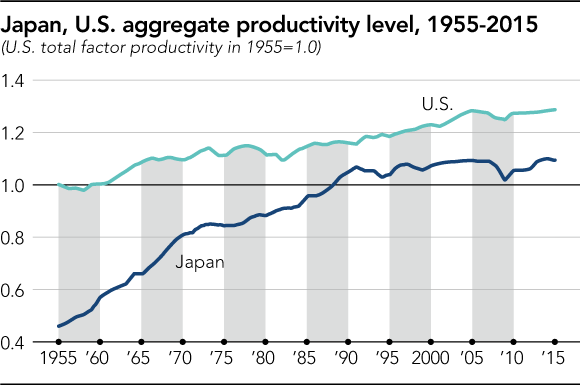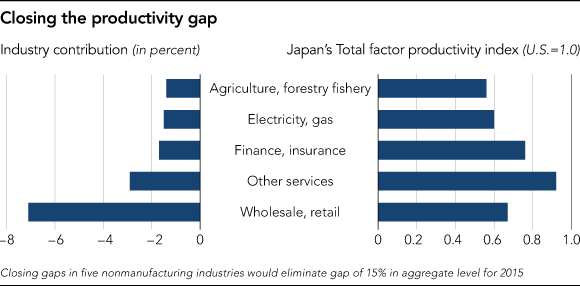The stunning victory of Prime Minister Shinzo Abe in Japan's October general election raises a key economic policy question—what next for Abenomics?
Since first taking office nearly five years ago, Abe has tried to boost economic performance through an aggressive monetary policy, a flexible fiscal approach and a growth strategy focused on promoting private investment.
This three-pronged response, which followed two decades of limited economic growth, was replaced by a new economic plan adopted in June this year, concentrating on raising productivity, driving innovation and trade, and energizing Japanese companies.
Abe's election success gives him the opportunity to implement this productivity-focused program. He should grasp the chance with both hands as the best way of reviving the Japanese economy and improving its global competitiveness.
As our first chart shows, Japan has, since the 1990s, seen no growth in productivity, as defined by the ratio of gross domestic product to the total of all inputs. As the chart demonstrates, Japanese productivity reached a peak in 1990, closely approaching U.S. productivity. Since then, the growth of Japanese productivity has been negligible, while U.S. productivity has continued to grow.

Meanwhile, Japan's aging labor force has fallen in size since 1999 and the Japanese population has declined since 2010. Moreover, Japan's government revenue will have to rise in relationship to GDP to meet the needs of an aging population.
In the first phase of Abenomics, aggressive monetary policy involved massive purchases of government securities by the Bank of Japan, beginning with the appointment of Gov. Haruhiko Kuroda in 2013 and continuing to the present. An example of flexible fiscal policy is the postponement of an increase in Japan's consumption tax rate scheduled for 2016, which has been re-scheduled for implementation for 2019.
The traditional approach to growth strategy in Japan was to subsidize favored industries to assist them in capturing domestic and foreign markets. When industries matured they tried to block competition through government regulations that protect markets by restricting new entrants. Prime Minister Abe's initial growth strategy was to drill through "bedrock" regulations to eliminate cartels and stimulate private investment.
A leading example of this approach was the effort to reform Japanese agriculture by limiting the influence of agricultural cooperatives. The cooperatives dominate markets for agricultural products and cartelize markets for agricultural inputs. A second example was Abe's attempt to increase competitiveness in the electricity, gas and other energy sectors, while creating markets for new energy sources.
Deregulation of trade and services is essential to stimulate innovation and investment in information technology. According to the OECD, Japan has the highest-quality labor force in the world in terms of workplace skills, as measured by literacy and numeracy. However, Japan's highly restrictive employment protections result in an inefficient allocation of a shrinking labor force. Trade agreements increase competition and stimulate incoming and outgoing foreign investment.
Early in 2016, Abe initiated a search for a new economic policy, building on the perceived successes of the first phase of Abenomics. I was one of three foreign economists chosen to advise the prime minister and the Cabinet Office on what was to become the second phase of Abenomics.
My main recommendation was to revitalize the Japanese economy by stimulating productivity growth. I identified non-manufacturing sectors protected from international competition as the primary focus of efforts to improve Japanese productivity. I identified the target industries by comparing sector-specific gaps in productivity between Japan and the U.S.
Industry-level productivity is defined in terms of ratios of industry output in each country to the corresponding inputs. Figure two shows that the most substantial gaps between Japan and the U.S. are in non-manufacturing sectors that are largely protected from international competition.
The aggregate productivity gap between Japan and the U.S. in 2015 was 15%. The contributions of individual industries to this gap are shown in the second half of the second chart. The largest contributor to Japan's productivity gap with the U.S. is wholesale and retail trade. Closing the productivity gaps between Japan and the U.S. in only five non-manufacturing industries oriented toward domestic markets would eliminate the overall productivity gap between the two economies.

The reformulation of Abenomics was completed with a new economic policy adopted called Growth Strategy 2017. The three major themes in this new, second, phase of Abenomics are: boost productivity, drive innovation and trade, and energize corporate activities.
I am sure that there were many sources of support for boosting Japanese productivity. Nonetheless, I was pleased to find my principal recommendation at the top of the list of three main priorities.
On July 12 of this year, the Cabinet Office summarized the Second Phase of Abenomics in a document entitled, simply, "Abenomics," which is the latest in a series of publications on Abenomics by the Prime Minister's Office. However, the Second Phase of Abenomics adopts a new set of objectives with a longer term perspective. The document is oriented toward the future -- future growth, future generations and a future Japan. This approach was the primary domestic component of Abe's highly successful re-election campaign.
To boost productivity, "Abenomics" proposes to reform and liberalize the traditional working style in Japan. Inefficient allocation of Japan's high quality labor force is a pressing problem. This can be traced to Japan's distinctive labor market institutions, especially "regular" employment, leading in many industries to rigid employment protection for the best educated and most experienced portion of the Japanese labor force. This is at the expense of "non-regular" employment, now amounting to some 40 percent of the labor force. Regular employees are, of course, mainly male, while non-regular employees are mainly female.
To drive innovation and trade, "Abenomics" proposes a major effort to provide faster distribution services for business, focusing on Japan's relatively inefficient wholesale and retail trade industry. It also seeks to increase productivity in infrastructure businesses, not least Japan's relatively inefficient construction industry. The third sector targeted for innovation is finance and insurance, an industry that would benefit from the development of financial technology in Japan. Building on the strength of Japan's medical care system, the final objective is to provide personalized medical care.
In addition to developing sustainable fiscal policy, Japan should shift the burden of taxation from investment to consumption. To energize corporate activities, "Abenomics" proposes to combine consumption tax increases with corporate tax reductions. Making the Japanese economy more hospitable to inward foreign direct investment would have a positive impact on productivity growth by stimulating technology transfers to Japan.
Abe's new economic strategy generated a widespread measure of political support in the Japanese general election of 2017. I conclude that the second stage of Abenomics has successfully identified the major challenges facing the Japanese economy. The implementation of new economic policies to meet these challenges will enable Japan to take advantage of the changes in the international environment that confront the Japanese economy and the economies of Asia now and in the future.
November 30, 2017, Nikkei Asian Review


